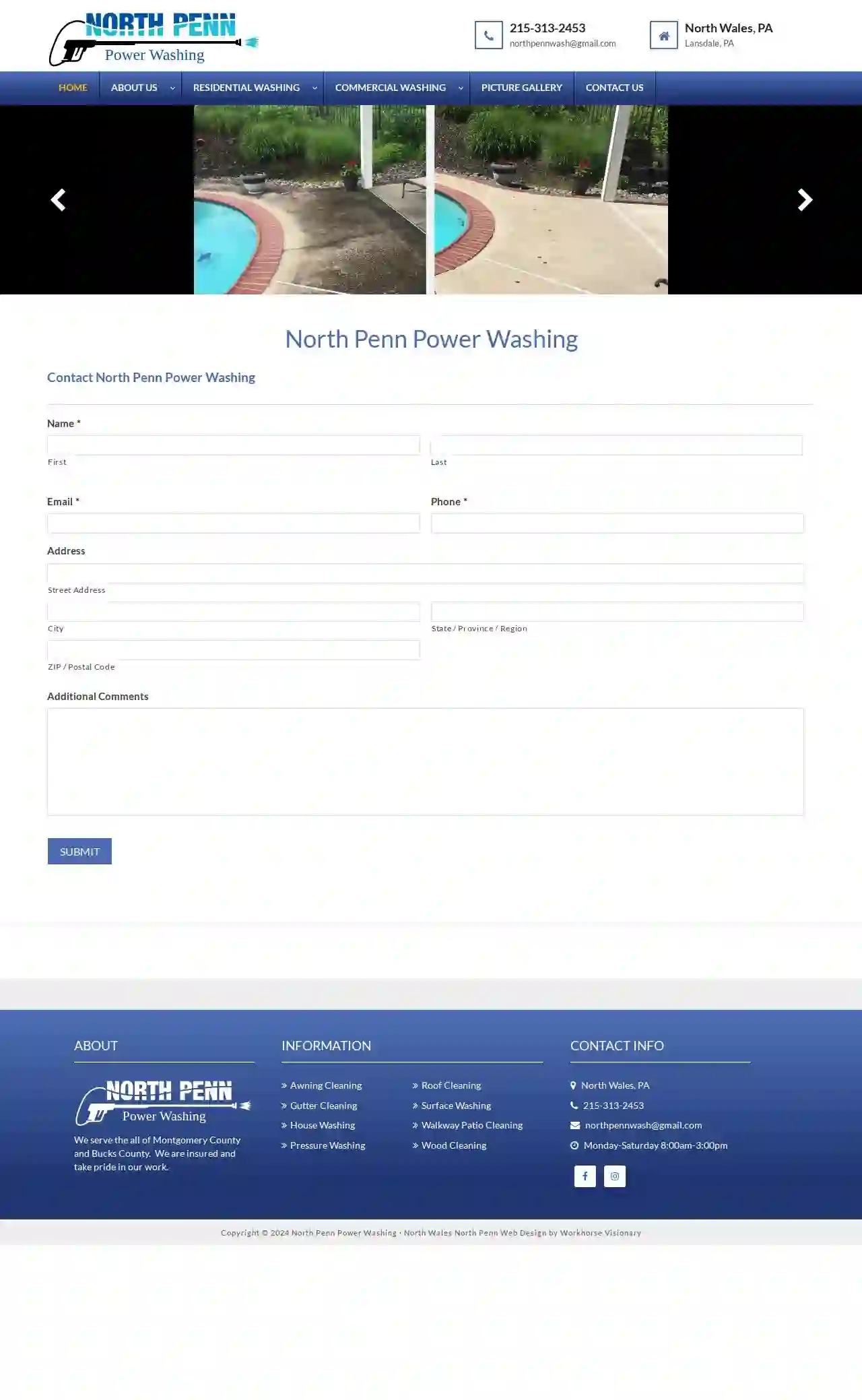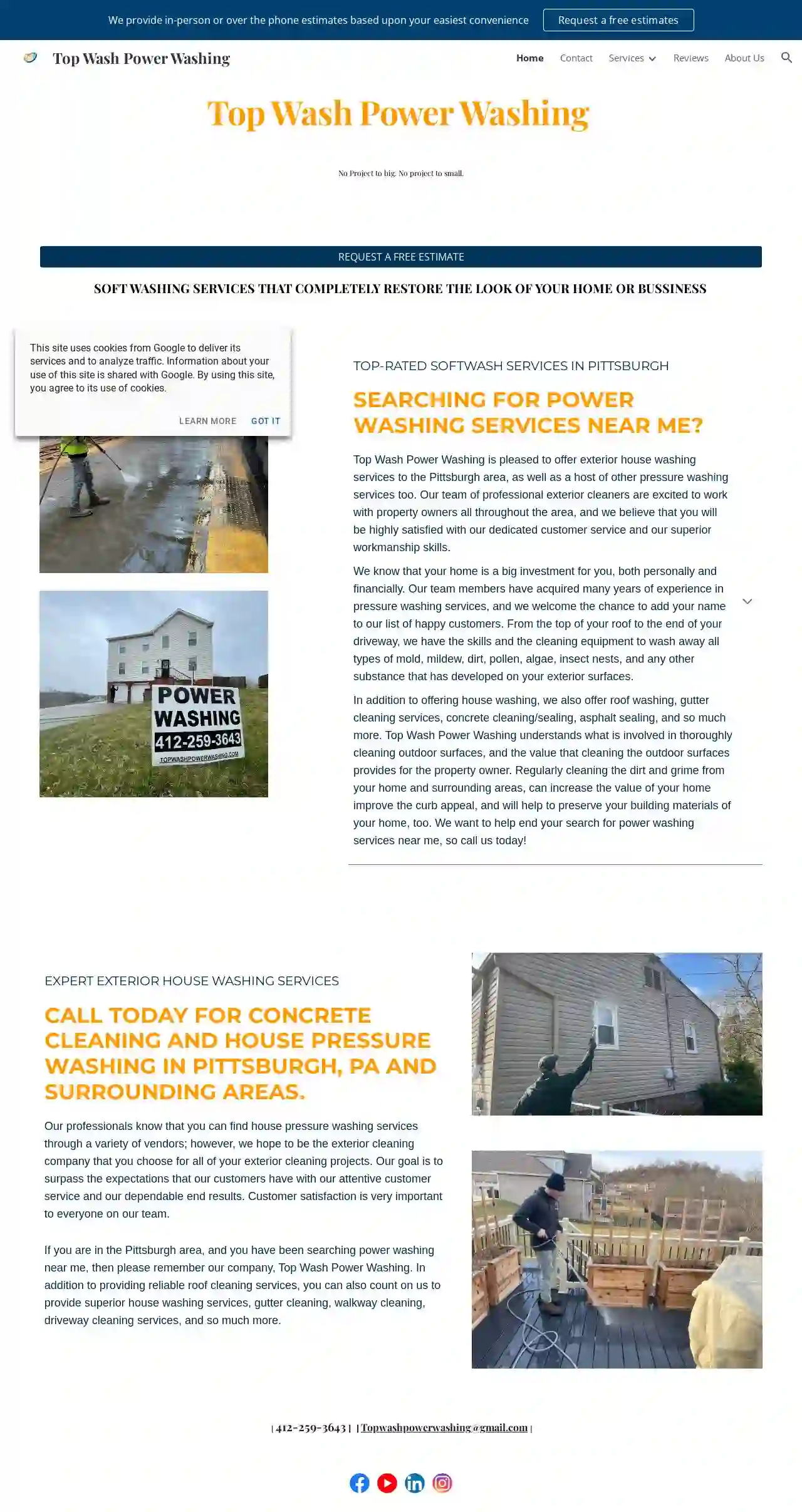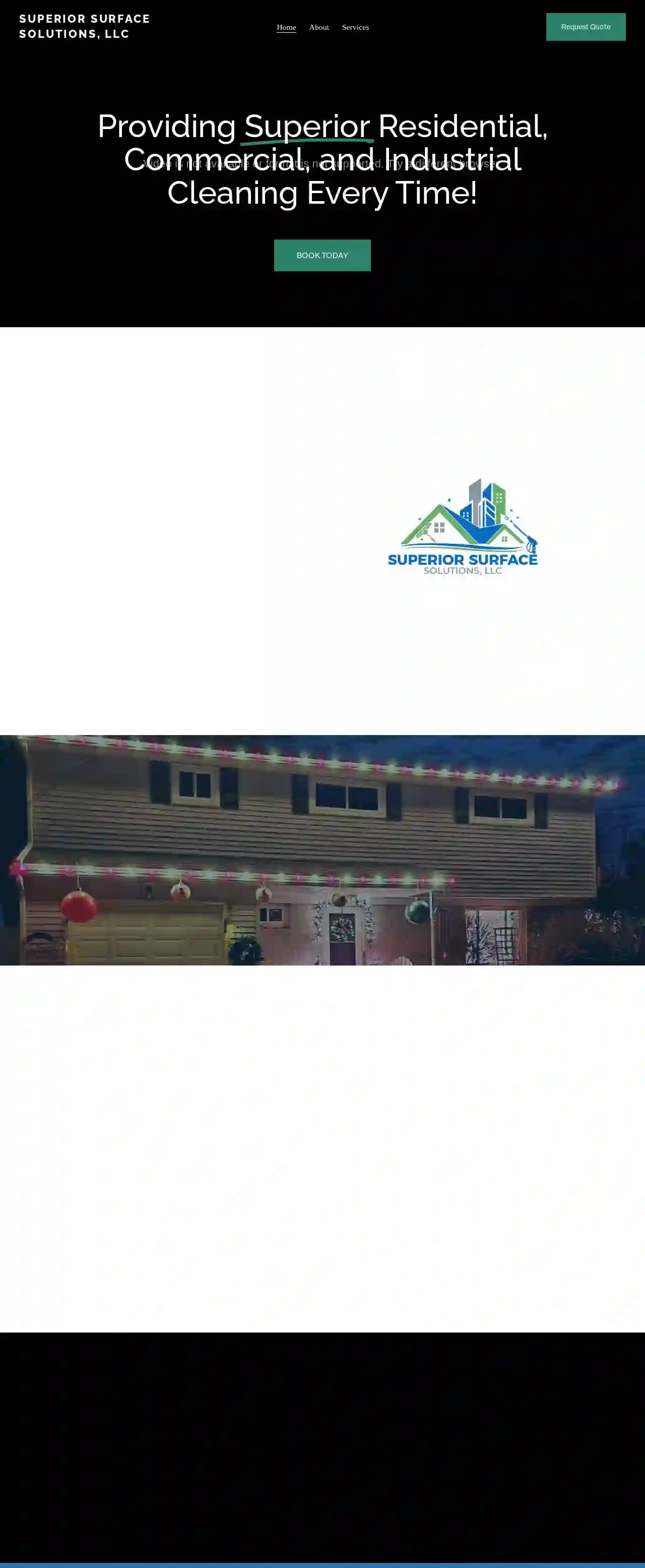Pressure Washing Swatara
Find the best Commercial Pressure Washing in Swatara
Get up to 3 Pressure Washing quotes for your project today! Compare profiles, reviews, accreditations, portfolio, etc... and choose the best deal.

Strick's Clean Pressure Washing
593 reviewsBangor, 18013, USThere’s Your Clean & Then There’s Strick’s Clean! At Strick's Clean Pressure Washing LLC, we're committed to being the top pressure washer serving the fine folks of Easton and surrounding communities. You won't find a more thorough exterior cleaning team in South West Pennsylvania. We offer a full line of services for residential and commercial applications. Whether you need playground cleaning or gutter cleaning and brightening, we're the pros to rely on. Call today to receive a free quote from the local leading pressure washer cleaning up your community, one property at a time. Soft Washing, Pressure Washing & Impeccable Exterior Cleaning Although we're known for our pressure washing in Easton, the truth is that we also offer soft washing services. We've become a top local pressure washer because we adapt our cleaning methods to better suit the job. Our first priority is to avoid damaging your property, which sometimes requires soft washing for gentler but just as thorough a cleaning. There's no reason to settle for less than the best, which is why you need to call Strick's Clean Pressure Washing LLC. For more information and a free estimate from the top pressure washer in Easton, call us now.
- Services
- Why Us?
- Accreditations
- Testimonials
- Gallery
Get Quote
North Penn Power Washing
557 reviewsNorth Wales, PA, USWe serve the all of Montgomery County and Bucks County. We are insured and take pride in our work. North Penn Power Washing Contact North Penn Power Washing Name* First Last Email* Phone* Address Street Address City State / Province / Region ZIP / Postal Code Additional Comments Powerwashing and Pressure Washing About We serve the all of Montgomery County and Bucks County. We are insured and take pride in our work. Information Awning Cleaning Gutter Cleaning House Washing Pressure Washing Roof Cleaning Surface Washing Walkway Patio Cleaning Wood Cleaning Contact Info North Wales, PA 215-313-2453 [email protected] Monday-Saturday 8:00am-3:00pm Facebook Instagram Copyright © 2024 North Penn Power Washing · North Wales North Penn Web Design by Workhorse Visionary
- Services
- Why Us?
- Gallery
Get Quote
Pressure Washer Systems
4.210 reviews1870 Woodville Ave., Pittsburgh, 15220, USPressure Washer Systems of PA is your one-stop shop for all your pressure washer needs. We've been serving the tri-state area since 2006, offering a wide selection of pressure washers and parts from top brands like Pressure-Pro, Delco, epps, Simpson, Hydro Tek, Mi-T-M, and more. We pride ourselves on our commitment to customer service and providing an exceptional shopping experience. With over 38 years of experience in the industry, our knowledgeable team can help you find the perfect pressure washer for your needs, whether you're a homeowner, contractor, or business owner. We offer competitive pricing, a vast selection, and free shipping on most pressure washers. Shop with confidence knowing you're getting the best value and service from Pressure Washer Systems of PA.
- Services
- Why Us?
- Gallery
Get Quote
Top Wash Power Washing
4.819 reviewsPittsburgh, USTop Wash Power Washing is pleased to offer exterior house washing services to the Pittsburgh area, as well as a host of other pressure washing services too. Our team of professional exterior cleaners are excited to work with property owners all throughout the area, and we believe that you will be highly satisfied with our dedicated customer service and our superior workmanship skills. We know that your home is a big investment for you, both personally and financially. Our team members have acquired many years of experience in pressure washing services, and we welcome the chance to add your name to our list of happy customers. From the top of your roof to the end of your driveway, we have the skills and the cleaning equipment to wash away all types of mold, mildew, dirt, pollen, algae, insect nests, and any other substance that has developed on your exterior surfaces. In addition to offering house washing, we also offer roof washing, gutter cleaning services, concrete cleaning/sealing, asphalt sealing, and so much more. Top Wash Power Washing understands what is involved in thoroughly cleaning outdoor surfaces, and the value that cleaning the outdoor surfaces provides for the property owner. Regularly cleaning the dirt and grime from your home and surrounding areas, can increase the value of your home improve the curb appeal, and will help to preserve your building materials of your home, too. We want to help end your search for power washing services near me, so call us today! Our professionals know that you can find house pressure washing services through a variety of vendors; however, we hope to be the exterior cleaning company that you choose for all of your exterior cleaning projects. Our goal is to surpass the expectations that our customers have with our attentive customer service and our dependable end results. Customer satisfaction is very important to everyone on our team. If you are in the Pittsburgh area, and you have been searching power washing near me, then please remember our company, Top Wash Power Washing. In addition to providing reliable roof cleaning services, you can also count on us to
- Services
- Why Us?
- Gallery
Get Quote
ICR Pressure Washing LLC
55 reviewsNot Specified, Norwalk, 44857, USICR PRESSURE WASHING LLC is a Limited Liability Company based in Norwalk, Ohio, serving the surrounding areas. We specialize in using a hot-water system combined with the soft-wash technique to provide a gentle yet thorough cleaning. Our mission is to "Restore the Old, Maintain the New" by extending the life of your surfaces. When requesting an estimate online, please provide the square footage, surface material, and any existing sealants or paints. We utilize public records and Google Earth to ensure accurate measurements, allowing us to provide precise estimates and streamline scheduling. We're dedicated to answering all your questions and ensuring a smooth experience.
- Services
- Why Us?
- Accreditations
- Our Team
- Testimonials
- Gallery
Get Quote
Judge Mobile Wash - Power and Pressure Washing
4.9112 reviewsPhiladelphia, USJudge Mobile Wash offers pressure cleaning services using the most environmentally-friendly methods possible. Our extensive knowledge comes from the solid base of family owned business that dates to the 1970’s. Contact (610) 692 – 9274 [email protected] Useful Links Pressure & Power Washing Services Residential Pressure & Power Washing Commercial Pressure & Power Washing The Eco-Friendly Pressure & Power Washing Copyright © 2024 Judge Mobile Wash Provided by: Digital Marketing Serv Pro
- Services
- Why Us?
- Gallery
Get Quote
Awesome Painting & Services
4.886 reviews2043 W 12th St, Erie, 16505, USAt Erie Awesome Painting, we take pride in delivering exceptional painting experiences. With over 30 years of experience, our team of skilled professionals is dedicated to transforming your vision into reality. We understand that your home or property is a reflection of your personal style, and we strive to enhance its beauty with meticulous craftsmanship and attention to detail. Our commitment to quality is unwavering. We utilize only the finest paints and employ the latest techniques to ensure flawless results that stand the test of time. From residential to commercial projects, we handle every project with the utmost care and professionalism. We believe in building lasting relationships with our clients based on trust, transparency, and exceptional service. We take the time to understand your needs, answer your questions, and guide you through every step of the process. Whether you're looking to refresh your interior, enhance your exterior, or tackle a specialized project, Erie Awesome Painting is your trusted partner. Contact us today to schedule a free consultation and let us bring your painting dreams to life.
- Services
- Why Us?
- Accreditations
- Our Team
- Testimonials
- Gallery
Get Quote
Penn Clean Pressure Washing
587 reviews1828 Pennland Ct, Lansdale, 19446, USExperience unparalleled cleanliness with our premier pressure washing services in the Greater Philadelphia area! At Penn Clean Pressure Washing, our team specializes in revitalizing both residential and commercial properties, ensuring they look their best year-round. We offer a comprehensive range of services, including metal building cleaning, roof cleaning using soft washing methods, and residential and commercial drone cleaning. Our advanced techniques and eco-friendly solutions guarantee effective and safe cleaning, removing dirt, grime, and stains without damaging surfaces. Trust us to enhance your property's curb appeal, prolong its lifespan, and provide a healthier environment. Choose us for your pressure washing needs and see why we're the top choice for homeowners and businesses across Philadelphia!
- Services
- Why Us?
- Gallery
Get Quote
Superior Surface Solutions, LLC
534 reviewsErie, USSuperior Surface Solutions’ main goal is to be the best pressure washing company in all of Northwestern Pennsylvania. In order to be the best, you have to be the most professional. That means being certified, licensed, and insured. Superior's employees are perfecting their craft each and every day with constant research and training. Along with our work, we are a customer first company. Our communication is quick, responsive, and very friendly. Like our customer service our prices are fair and honest. We Offer Holiday Lighting! Installation, removal, storage and much more. To view a complete list of our amazing services in your area, click the link below! We provide a numerous amount of different pressure washing and sealing services. Along with gutter cleaning, window washing, and underground landscape drain cleaning. The final service we provide is unlike the rest. Superior installs Christmas lights. In addition to all of our other home perfecting services, we also hang, remove, and store lights for local residents and businesses in the area. We are constantly changing and improving to provide superior home perfecting services. Customer happiness and satisfaction is our main priority as we grow our company within the extraordinary community of Erie.
- Services
- Why Us?
- Testimonials
- Gallery
Get Quote
Brizzy Softwashing and Cleaning Services
527 reviewsYork, USBrizzy Contracting is a Long Island based home remodeling company dedicated to providing high-quality services in Power/Pressure Washing, Interior & Exterior Painting, and Shrink Wrapping. We pride ourselves on our commitment to excellence, ensuring 100% communication and client satisfaction. Fully licensed, insured, and staffed, we handle any task, big or small, with skilled workmanship and a dedication to customer care. Whether it's a single service or a large-scale project, Brizzy Contracting delivers on its promise of "Always Dedicated and Devoted."
- Services
- Why Us?
- Gallery
Get Quote
Over 60,241+ Janitorial Services on our directory
Our cleaning service providers operate in Swatara & beyond!
CleaningMatch has curated and vetted Top Cleaning Companies in Swatara. Find a top & reliable pro today.
Frequently Asked Questions About Pressure Washing
- Degreaser: For optimal results, pre-treat the oil stains with a degreaser specifically designed for driveways. Allow the degreaser to sit for the recommended time before pressure washing.
- Hot Water: Using hot water in your pressure washer can be more effective at breaking down oil than cold water.
- Surface Cleaner: Using a surface cleaner attachment for your pressure washer can provide a more even and efficient cleaning result.
- Online Reviews: Check online reviews on platforms like Google, Yelp, and Facebook to gauge customer satisfaction and service quality.
- Experience and Expertise: Look for companies with a proven track record and experience in pressure washing various surfaces.
- Licensing and Insurance: Ensure the company is licensed and insured to protect you from liability in case of accidents or damage.
- Equipment and Techniques: Inquire about the company's equipment and techniques to ensure they use appropriate pressure levels and cleaning solutions for different surfaces.
- Quotes and Pricing: Obtain detailed quotes from multiple pressure washing companies and compare their pricing. Make sure the quotes are transparent, outlining all services and costs.
- Professionalism and Communication: Choose a company that is responsive, provides clear communication, and demonstrates professionalism in its interactions.
- Pressure Washing: Suitable for hard surfaces like concrete, brick, stone, and decks that can withstand high pressure. Effective for removing stubborn dirt, grime, and stains.
- Soft Washing: Best for delicate surfaces like roofs, siding, painted surfaces, and wood fences that may be damaged by high pressure. Effective for removing mold, mildew, algae, and other contaminants without causing harm.
- Experience: 'How long have you been in business, and what types of pressure washing projects do you specialize in?'
- Licensing and Insurance: 'Are you licensed, insured, and bonded? Can I see proof of coverage?'
- Equipment and Techniques: 'What type of pressure washer do you use? What cleaning solutions do you use, and are they safe for my surfaces?'
- Safety Precautions: 'What safety precautions do you take during pressure washing?'
- Surface Preparation: 'Will you need to move any furniture or objects before pressure washing?'
- Water Usage: 'Do you use a water reclamation system or other methods to conserve water?'
- Cleanup: 'How do you handle cleanup after pressure washing?'
- Guarantees: 'Do you offer a satisfaction guarantee?'
- References: 'Can you provide references from previous clients?'
Can pressure washing remove oil stains from my driveway?
If DIY pressure washing doesn't completely remove the oil stains, consider hiring a professional pressure washing company. They have specialized equipment and experience in dealing with stubborn stains.
How do I find a good pressure washing service?
Utilize online directories like CleaningMatch to find and compare qualified pressure washing services in your area.
How do I know if I need pressure washing or soft washing?
If you're unsure which method is best for your surfaces, consult with a professional pressure washing company. They can assess your needs and recommend the most appropriate cleaning method.
What questions should I ask a pressure washing contractor before hiring them?
By asking these questions, you can gather valuable information and choose a pressure washing contractor that meets your requirements.
Can pressure washing remove oil stains from my driveway?
- Degreaser: For optimal results, pre-treat the oil stains with a degreaser specifically designed for driveways. Allow the degreaser to sit for the recommended time before pressure washing.
- Hot Water: Using hot water in your pressure washer can be more effective at breaking down oil than cold water.
- Surface Cleaner: Using a surface cleaner attachment for your pressure washer can provide a more even and efficient cleaning result.
If DIY pressure washing doesn't completely remove the oil stains, consider hiring a professional pressure washing company. They have specialized equipment and experience in dealing with stubborn stains.
How do I find a good pressure washing service?
- Online Reviews: Check online reviews on platforms like Google, Yelp, and Facebook to gauge customer satisfaction and service quality.
- Experience and Expertise: Look for companies with a proven track record and experience in pressure washing various surfaces.
- Licensing and Insurance: Ensure the company is licensed and insured to protect you from liability in case of accidents or damage.
- Equipment and Techniques: Inquire about the company's equipment and techniques to ensure they use appropriate pressure levels and cleaning solutions for different surfaces.
- Quotes and Pricing: Obtain detailed quotes from multiple pressure washing companies and compare their pricing. Make sure the quotes are transparent, outlining all services and costs.
- Professionalism and Communication: Choose a company that is responsive, provides clear communication, and demonstrates professionalism in its interactions.
Utilize online directories like CleaningMatch to find and compare qualified pressure washing services in your area.
How do I know if I need pressure washing or soft washing?
- Pressure Washing: Suitable for hard surfaces like concrete, brick, stone, and decks that can withstand high pressure. Effective for removing stubborn dirt, grime, and stains.
- Soft Washing: Best for delicate surfaces like roofs, siding, painted surfaces, and wood fences that may be damaged by high pressure. Effective for removing mold, mildew, algae, and other contaminants without causing harm.
If you're unsure which method is best for your surfaces, consult with a professional pressure washing company. They can assess your needs and recommend the most appropriate cleaning method.
What questions should I ask a pressure washing contractor before hiring them?
- Experience: 'How long have you been in business, and what types of pressure washing projects do you specialize in?'
- Licensing and Insurance: 'Are you licensed, insured, and bonded? Can I see proof of coverage?'
- Equipment and Techniques: 'What type of pressure washer do you use? What cleaning solutions do you use, and are they safe for my surfaces?'
- Safety Precautions: 'What safety precautions do you take during pressure washing?'
- Surface Preparation: 'Will you need to move any furniture or objects before pressure washing?'
- Water Usage: 'Do you use a water reclamation system or other methods to conserve water?'
- Cleanup: 'How do you handle cleanup after pressure washing?'
- Guarantees: 'Do you offer a satisfaction guarantee?'
- References: 'Can you provide references from previous clients?'
By asking these questions, you can gather valuable information and choose a pressure washing contractor that meets your requirements.